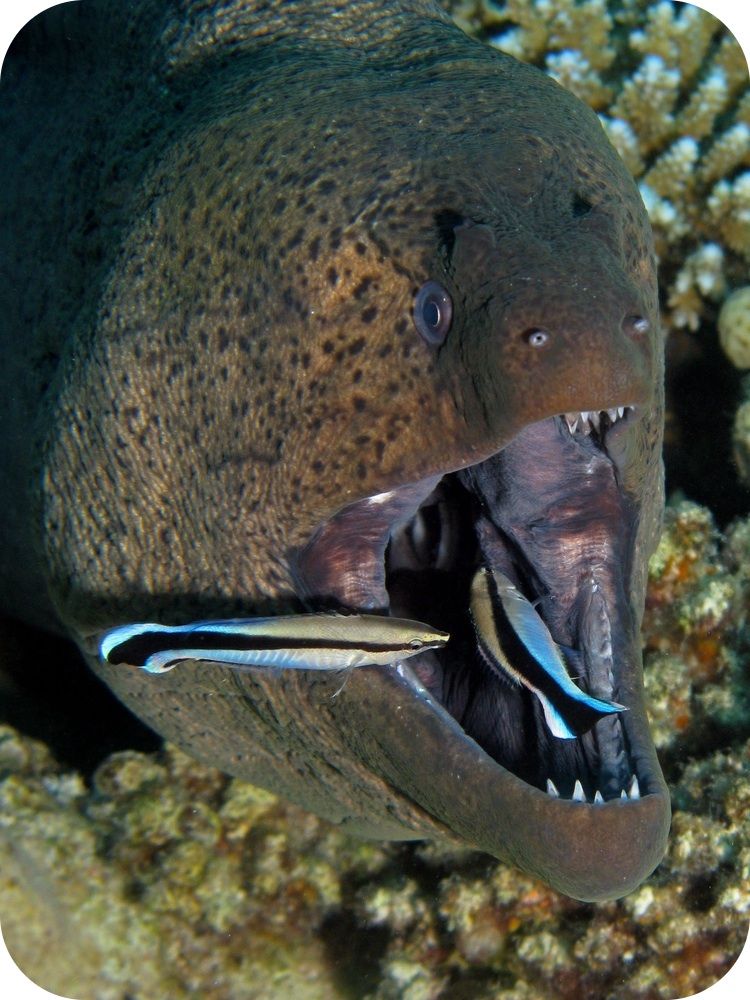12.9: Symbiosis
- Page ID
- 14445

Is this little fish about to become lunch?
Actually, this big fish is not opening his mouth to munch on these little fish. He is opening his mouth to get his teeth cleaned! These small fish eat dead skin and parasites from his body. Both types of fish benefit from this relationship.
Symbiosis
Symbiosis describes a close and long-term relationship between different species. At least one species will benefit in a symbiotic relationship. These relationships are often necessary for the survival of one or both organisms. There are three types of symbiotic relationships: mutualism, commensalism, and parasitism.
- Mutualism is a symbiotic relationship in which both species benefit.
- Commensalism is a symbiotic relationship in which one species benefits while the other is not affected.
- Parasitism is a symbiotic relationship in which the parasitic species benefits while the host species is harmed.
An example of a mutualistic relationship is between herbivores (plant-eaters) and the bacteria that live in their intestines. The bacteria get a place to live. Meanwhile, the bacteria help the herbivore digest food. Both species benefit, so this is a mutualistic relationship. The clownfish and the sea anemones also have a mutualistic relationship. The clownfish protects the anemone from anemone-eating fish, and the stinging tentacles of the anemone protect the clownfish from predators (Figure below). Another example of this type of symbiotic relationship is the relationship between the plover bird and the African crocodile. The tiny blackbird acts as a toothpick for the fierce crocodile, and helps by removing tiny morsels of food that are stuck between the crocodile's teeth. These food remains are the source of food for the bird. Another example is between the ostrich and the zebra. The ostrich always moves with the herd of zebras since it has a poor sense of hearing and smell, whereas the zebra has very sharp senses. The ostrich has a keen sense of sight, which the zebra lacks. Hence, these two species depend on each other to warn one another of any nearby imposing dangers.
Commensal relationships may involve an organism using another for transportation or housing. For example, spiders build their webs on trees. The spider gets to live in the tree, but the tree is unaffected. Other commensal relationships exist between cattle egrets and livestock. Cattle egrets are mostly found in meadows and grasslands are always seen near cattle, horses and other livestock. These birds feed on the insects that come out of the field due to the movement of the animals. They even eat ticks, fleas, and other insects off the back of animals. The relationship between tigers and golden jackals is also commensalism. The jackal alerts the tiger to a kill and feeds on the remains of the prey left by the tiger. This is not a mutualistic relationship as the tiger does not provide anything to the jackal.
Parasites may live either inside or on the surface of their host. An example of a parasite is a hookworm. Hookworms are roundworms that affect the small intestine and lungs of a host organism. They live inside of humans and cause them pain. However, the hookworms must live inside of a host in order to survive. Some parasites may kill their host but most do not. It's easy to see why; if a parasite kills its host, the parasite is also likely to die. Parasites are found in animals, plants, and fungi. Hookworms are common in the moist tropic and subtropic regions. There is very little risk of getting a parasite in industrialized nations.

Science Friday: Invasion of the Zombees: A Bee Horror Film
What would cause bees to suddenly drop dead? In this video by Science Friday, Lila Higgins discusses the parasite this is quietly causing these bees to die.
Summary
- Symbiosis describes a close and long-term interaction between different species.
- In a mutualism, both species benefit; in a commensalism, one species benefits while the other is not affected.
- In a parasitism, the parasitic species benefits, while the host species is harmed.
Explore More
Use the resource below to answer the questions that follow.
- Symbiosis: Mutualism, Commensalsim and Parasitism at http://www.youtube.com/watch?v=zSmL2F1t81Q (5:17)
- What defines a symbiotic relationship?
- Is the benefit gained by each individual in a mutualistic relationship equal?
- What could a mutualistic relationship, in which one organism receives little benefit, also be called?
- What type of relationship exists between the clownfish and the sea anemone?
- What are the two explanations for where a clownfish's protective mucus comes from?
Review
- What is symbiosis?
- Distinguish between mutualism and commensalism.
- Describe an example of a symbiotic relationship.
- What's an example of a parasite?

